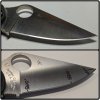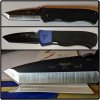RE: "Is a Mora a true Scandi?"
Yes, and No (closer to No). I have had a number of Mora knives and have witnessed a number of variations on new knives that range from a blade that was ground as a "true Scandi" (one bevel extending to the apex, typically at ~10-13°per side), then put to a belt to polish and/or debur the edge resulting in Scandi Bevels that have some amount of micro-beveling (amount varies from knife to knife, which is why I would choose to hand-select a $15 knife from a display), to one's that have very little sign of any secondary grinding. The actual edge-bevel (after the micro-bevel) may range from 15-22°per side (30-45° inclusive), considerably duller/steeper the the Scandi grind primary bevels. So, some are close to a "true Scandi" some are further away.
I typically reprofile Mora's, Enzo's, etc. to have a single, flat bevel (per side) from transition to apex. It may take a couple/few sharpenings (removing weakened material near edge) before the edge becomes stable for long term use. Mora kinda forgoes this process by dumbing down the apex initially (as do most mfr's).
RE: "And, are you saying that I can dull the geometry while doing things like touch-ups on the sharpmaker, even though the knife feels sharper in the short-term?
Yes, exactly.
Unless steel is removed from the primary bevel during sharpening, you are typically effectively increasing the edge apex angle progressively dulling the geometry from the initial profiling/sharpening. Each time you "touch-up", it 'can be' sharper than just before ..., BUT the geometry will each time be slightly less acute than time before.
On the contrary, a secondary bevel that has been laid back (material removed from the shoulder transition Primary/Secondary in a flat plane) where material has been removed from the Primary Bevel will sharpen the geometry.
All of my comments so far relate to flat bevels, but would also loosely apply to say a Scandi-Vex, etc. when in proper context (removing material from the edge dulls or steepens the geometry of the
Ogive (click-link), where-as removing material from behind the edge is the process of sharpening the geometry).
Back to my first post (#2);
Now knowing you already have a "Scandi" Mora, and you are aware the "Sharpie-Trick" during sharpening, I think it would be an excellent learning example for you to reprofile that Mora with the goal being to eliminate the micro-bevel. To work the steel to stone (sand-paper, etc.) focusing on removing material evenly from the bevel flats to the point you achieve a consistent bur extending ricasso to tip on both sides along with a crisp, fresh apex. Get a feel for how the blade reacts when you put even pressure on the flats (a gliding feeling), a bit of pressure back onto the transition (a skipping/drifting feeling), and how the blade responds when you put a little pressure near the edge (gets sticky on the stone). BEWARE; small amounts of material removed near edge will mean LARGE amounts of materials will need removing from the flats (loads of work added). If you've never felt/used a true Scandi, you will be in for a treat. A 12 year knife acquaintance/friend of mine recently crossed this point and has become crazy for maker-knives with Scandi grinds. He previously had negative feelings related to "Scandi" knives because of numerous experiences with Scandi+Micro versions.
EDIT: rereading your OP, that you are using the SharpMaker. Have you experimented with using the stones in the horizontal position (one or two stones) along with the Sharpie-Method ?
If not, I highly suggest you review Sal Glesser video related to using the SharpMaker in this configuration. I find it much easier to get "the feel" that I have mentioned, ESPECIALLY when sharpening Scandi profiles.



